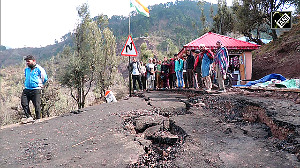A water fountain spouts blood. A dog walks around with a leash around its neck, ominously suspended in mid-air. No, these are not attempts to create a sci-fi thriller but ambient advertisements.
In a market with millions of brands, each vying for the consumer's time and attention, advertisers are resorting to such 'unusual' ideas to woo customers.
Ambient advertising is a form of advertising done in a non-traditional media or using a medium in a way it has never been used before either as part of the mainstream campaign or as a stand alone activity. It helps brands be more a part of people's lives, say advertising professionals.
"Ambient advertising is a brand message that hits you when you least expect it. It is not restricted to any size, shape or format. They have no boundaries. And that is what makes it so refreshing," says Rajiv Rao, executive director, O&M, Mumbai.
"More and more consumers are moving from just transactions to experiences with the brand. Ambient helps break through the clutter and reach out to all," says Grey Group CEO, Nirvik Singh.
The blood spouting fountain was part of a promotional campaign for a horror film festival and the dog with the 'unmanned' leash was to a promote a film, The Invisible premiering on a popular television channel.
"Advertisers are always trying new ways to reach consumers, use spaces which have not yet been used," says Jignesh Maniar of ON Media.
Ambient advertising is a relatively new phenomenon in India whereas the West has long used this as another way of effectively reaching out to consumers. It provides that many more options to, what ad makers call, 'tell the story.'
"Outdoor in India is in chaos. In developed countries outdoor is very organised. Ambient advertising is also infrastructure dependent. We need more ideas and also outdoor that will do justice to those ideas. Ambient is much more exploited in the West. In India we are warming up to it," says McCann Erickson, regional executive creative director, Asia Pacific, Prasoon Joshi.
"We have started walking on the path. These could be called the first hesitant steps. Scope for ambient advertising is humungous. More and more people are coming around. (on ambient advertising). The onus of developing ambient ideas is on the communicating agency, says Bobby Pawar, chief creative officer, Mudra Communications.
The question which then comes to mind is that if it is indeed difficult to 'arrest' a preoccupied consumer's mind how effective can ambient ideas be?
"Ambient ads are as effective as the idea. Ambient advertising should not be mistaken for direct selling. Brands should not just communicate. They should try to create experiences unique to the brand," says Pawar.
"You need to respect people's time and space. The experience must be rewarding for the consumer both intellectually and in terms of entertainment value. Do something good, do it at one place, it will make news, people will talk about it. Get consumers to become the medium for the brand," he adds.






 © 2025
© 2025